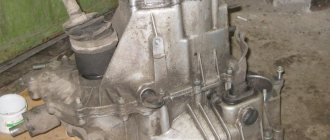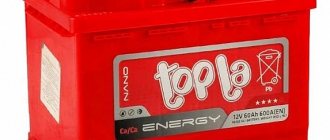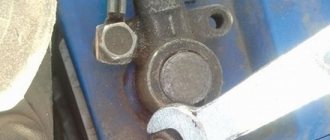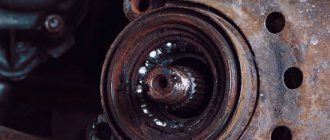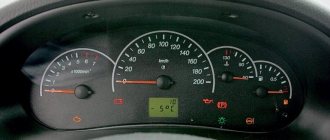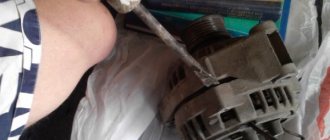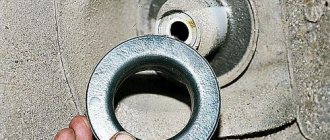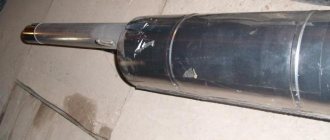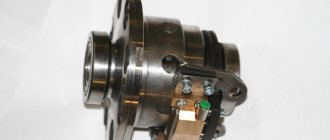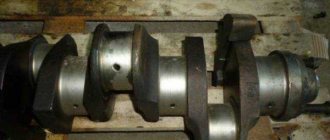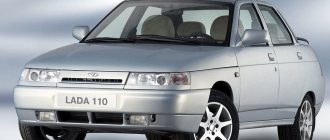There was a slight vibration at speed. I started digging into this matter. I got to the diff and it turned out that it had play((The time has come to replace the bearings. I naturally grabbed my head, imagining HOW MUCH the spare parts would cost(I come home, get into the existential situation and fall into a stupor. Differential bearings, ORIGINAL, 2 pieces cost 1400 rubles O_o. Plus non-original filter RUB 500. Nice)) I ordered everything, and then I went to remove the box)
We unhook everything we can from the box. We drain the ATP. We hang the engine. Unscrew the box from it and remove it)
Having unscrewed a shitty cloud of bolts in a circle, we cut the box in half. Do this VERY carefully! There are no gaskets there! Everything is sealed! It is very easy to damage the mating surface! After unscrewing the bolts, the box should lie on its side with the bolts facing up! Having removed one half, we see another 2-3 liters of ATP inside.
I didn’t know about this((I definitely spilled a liter(
Well, I finally had some time to post a report on replacing the diff bearings; I carried out the replacement during the New Year holidays, but I didn’t have time to show you to my friends.
So a little theory. If a noise appears from the front while the car is moving, it increases when accelerating and decreases when stopping, no matter what gear or neutral. These are either wheel bearings or differential bearings. The first thing you need to do is check the wheel bearings with this phonendoscope. We hang up the front wheels one by one, secure the car with the handbrake and rollbacks, with the help of an assistant we accelerate to those speeds at which the hum appears, and listen to each bearing from the pit. Attention: when one of the drive wheels is raised, the differential will not allow the car to start moving, but will only rotate the wheel that is lifted off the ground. You just need to secure the car well so that it doesn’t jump off the jack.
.
If none of the wheel bearings are humming, then only the diff bearings remain; they can also be listened to in the manner described above. Well, in my case the differential bearings were damaged. Spare parts were ordered in advance. What is needed to replace bearings Lanos A15SMS gearbox F16: 1. Bearings 2 pcs code 96335754
2. Drive oil seals 2 pcs
code 25187787
3. O-rings (left and right, different)
code 96243158 (left), 96243159 (right)
4. Gearbox pan gasket
code 96179241
5. Thread lock 6. New gearbox oil is desirable As Murzilka writes, the bearings are adjusted on a disassembled box, with the secondary shaft gear (main pair) removed, with a preload of 2 kg. That is, you need to disassemble the box and tighten the bearings with the differential rotating freely. Well, since on our boxes the diff bearings can be replaced only by removing the pan, a problem arises with adjusting these bearings. I scoured a bunch of forums, including Drive2, no one had done this, the answer was found only on one (Vektrovsky in my opinion) and it was superficial, I’ll write which one below, I decided to take a risk. There was also a thought that the drives were hanging too much, but it was decided to postpone this problem, because... This is a problem with our differentials and should be eliminated by tightening the seats for the drive. Well, since the seals do not leak, and the drives do not dangle relatively much, the problem is put aside. I also looked for the dimensions of the bearings to replace with an analogue in size, asked on various forums and again to no avail. That's why I'm telling you their sizes.
Thickness 17mm Outer diameter 63mm Inner diameter 38mm Tapered bearing.
Well, perhaps it's time to get started. Attention, this procedure requires some skills and tools, if you are not confident in yourself, leave this undertaking for servicemen
We hang it in front of the car
Removing and disassembling the gearbox
Replacing a VAZ 2110 bearing
Needless to say, before you start replacing the bearing, you should remove the box from the car and disassemble it.
Removing the car box
Replacing a bearing on a VAZ 2110
- We install the car on the inspection hole;
- we lift the hood of the car and fix it tightly with something so that it does not wobble;
- remove the battery terminals;
- drain the oil from the gearbox.
- we start by dismantling the crankcase protection (it is secured with bolts that should be unscrewed);
- the ground wire must be removed by unscrewing the bolt;
- we find the tip of the clutch cable, which disengages the clutch and loosen the tightening of the nuts;
- remove the cable end;
- remove the starter and traction relay from the car;
- Now you should loosen the clamp holding the gear shift rod;
- the cable is disconnected from the speedometer drive;
- the reverse light wire is disconnected;
- we separate the guy wires from the car's suspension arms.
- we find how the tie rod ball joint is attached to the swing arm (this is a nut that should be unscrewed);
- Now you should press out the ball joint pin (a special puller is used for this);
- remove the ball joint by unscrewing two bolts;
Bolts securing the ball joint
We take a pry bar, with which we squeeze out the shank of one grenade of the front wheel drive from the gearbox (the CV joint should be moved to the side);
You need to insert something instead of the grenade shank. For example, it could be an old CV joint (see VAZ 2110 replacing a CV joint - how to do it) or another technological plug.
- repeat the same operation with the second grenade;
- it's time to unscrew the clutch housing shield;
- Now you need to start removing the crankcase itself, which is attached to the cylinder block.
- we proceed to removing the engine, which needs to be attached to a beam by a special eye, using a long bolt with a hook for this;
- unscrew the nuts securing the engine to the gearbox;
- we move the box away from the engine, removing the input shaft from the clutch;
- remove the box.
Analysis of the gearbox
The gearbox has been removed and now needs to be disassembled. Let's start the process:
The box should be thoroughly cleaned of oil and dirt.
- now the box is placed on its butt (in other words, vertically upward);
- the rear gearbox cover is dismantled (to do this, unscrew six nuts);
- Now you will need to remove the clutch cable bracket;
Dismantling the clutch cable bracket
- We carefully move the back cover of the box from its place, to do this, hitting it with a rubber hammer;
- completely remove the rear cover from the gearbox housing;
- Next, the sealing gasket of the gearbox housing is removed.
- now you need to engage third and fourth gears;
- then, after unscrewing the bolt securing fifth gear, engage 5th;
- move 5th gear down so that the coupling splines engage the gear.
- we unscrew the nut on the secondary shaft, first unlocking it;
- the same thing is done with the input shaft, or rather with its nut;
- the 5th gear synchronizer together with the fork is removed;
- the driven gear is also removed from the secondary shaft;
- The needle bearing is also dismantled, if necessary.
Replacing bearings on a VAZ 2110
After this, you need to dismantle the following parts and elements of the gearbox in order to easily get to the differential:
- input shaft drive gear;
- primary and secondary shaft;
- rear engine mount;
- clutch housing;
- gearbox housing.
In addition, the following must be extracted:
- fork and rod of first and second gears;
- third and fourth gear shift fork;
- reverse fork with gear and axle.
Adjustment stages
- After the distance has been adjusted, it is necessary to check the play on the axle. To do this, attach the pointer to a tripod, and rest the probe against the end of the driven gear. The backlash is measured, and the part is rocked in the direction of the axis.
- The adjustment nut, which is located on the opposite side from the driven gear, sets the play on the axis from 0.055 to 0.035 mm.
- Then the nut is tightened and the preload is set: 0.1 mm, if the bearing mileage is no more than 10 thousand km; 0.05 mm – if more than 10 thousand km. Turning the nut one notch is equal to “compressing” the bearing by 0.03 mm.
- After making the adjustment, you need to tighten the bolts on the bearing cap and install the locking plates. The lateral distance is checked again.
Causes of automatic transmission malfunction - typical
Lever links
In old-type automatic transmissions, which had a mechanical connection of the selector directly with the transmission, the automatic transmission lever often fails, which makes it impossible to change the operating modes of the transmission. The repair in this case consists of replacing the broken selector and gearbox rocker. Such breakdowns manifest themselves as difficulty in moving the automatic transmission selector. Ultimately, the lever stops moving and the automatic transmission needs to be repaired. For some modifications of automatic transmissions, this work can be carried out without removing the gearbox itself from the car, which somewhat simplifies repair work.
Oil is leaking
A common malfunction of an automatic transmission is the presence of oil leaks from under the sealing gaskets. That is why the car owner is recommended to regularly inspect the condition of the gearbox on a lift or garage pit. If there are any oil leaks on the gearbox itself, you should contact experienced specialists. In this case, eliminating such problems is not particularly difficult and consists of replacing the gaskets and changing the transmission oil.
Regularly inspect your vehicle for leaks on the pallet.
Control block
In some cases, there may be problems with the transmission control unit. The control unit may incorrectly select the speed to change gears or independently block the operation of the transmission. Elimination of breakdowns associated with the operation of the control unit and the electrical part of the transmission consists of replacing failed units and control loops.
Problem with the ECU (control unit) - solved by replacing the unit
Problems with the valve body
Such malfunctions can occur in a number of cases. For example, improper operation of the gearbox. When the car enthusiast does not warm up the machine, but immediately starts driving. Symptoms: vibrations, shocks, impacts. In some cases, the car refuses to move. On modern cars, a malfunction with the GB is signaled on the on-board computer.
Torque converter problem
Such problems can only be resolved by repair. In general, such work is cheaper than work on the valve body and ECU. The symptoms are: knocking, rustling sounds, vibration, car dynamics suffer, when changing the oil in the box, there are copious amounts of chips in the pan.
Maintenance
Maintenance of the UAZ bridge is simple and comes down to monitoring the level of lubricant and topping it up and replacing it. The second point is to check the seals for leaks. It is regularly necessary to check the reliability of the fastenings, especially if the machine is used in difficult road conditions. Eliminate axial play in the differential bearings in a timely manner.
Assembly and connection diagram
When assembling the structure, do not remember several features:
- Press the bushing into the trunnion flush with the end of the washer socket. After completing the procedure, the sleeve must be deployed;
- Place one thrust washer inside the trunnion, the second - in the support. The oil lines in the thrust washers should face the joint. The washer is secured by punching in 3-4 places;
- When installing the hinge, add lubricant to the ball joint;
- Treat the pins and bushings with liquid lubricant.
What are the types of automatic transmission malfunctions?
It is difficult to imagine the modern world without a car with an automatic transmission. Frequent traffic jams and traffic lights at every intersection made the automatic machine an indispensable thing for moving around cities. Perhaps this is why most significant concerns are gradually abandoning mechanics in favor of automatic gear shifting. This trend is gradually coming to our country, and with it the problems associated with automatic transmissions.
Any current design in a car has two operating principles: mechanical and electronic. Automatic transmission is no exception. Physical gear shifting is carried out by mechanisms, and algorithms are calculated by the software component. Therefore, all causes of failure are divided into two large groups:
- mechanical breakdowns. They occur in the hydraulics and physical drives of the gearbox;
- electronic system failures. Malfunctions of programs or electrical parts of the machine.
Let's look at each of these points separately.
Mechanical and hydraulic problems
Most often, due to mechanical failures, the following elements break:
- wear of the shafts or gears of the mechanism;
- damage or wear of clutches, discs, brakes inside the transmission;
- problems in the operation of the torque converter;
- wear of the hydraulic unit;
- clogging of the oil channels of the box;
- oil pump failure.
From the above list, you can see that the main problems in the mechanical part begin when parts wear out or the use of unsuitable oil. It is worth noting that this is a real stumbling block for automatic transmissions: more often than not, car enthusiasts simply run out of service life of the internal structures of the box. This once again proves the security of this type of transmission.
Related product:
Suprotek Reducer additive for transmission units
Restores the surfaces of gear teeth and bearing races in gearboxes of any type. This reduces noise and vibration during operation of the unit, facilitates its operation, and extends its service life by 2.5-3 times.
A transmission differential is a type of mechanical gearbox that transmits rotation from a driveshaft to an axle shaft. This device allows the wheels to spin at different speeds when the car turns. For rear-wheel drive vehicles, this unit is located in the drive axle housing, and for all-wheel drive vehicles, it is located in the transfer case.
Causes of machine failure
The following are the main causes of automatic transmission failure:
- resource consumption or wear of parts. The most banal, but at the same time the most common reason. Even neat and careful owners sooner or later come to this situation;
- using low-quality or unsuitable oil. Another common mistake. In pursuit of savings, drivers use uncertified oils. This causes rapid breakdown of the automatic transmission;
- service with low-quality consumables. Here again the savings may be deliberate;
- inexperienced or irresponsible mechanic. You will never guess how decently a person will approach working with a car. Try to contact trusted specialists;
- machine use habits. Many habits lead to wear and tear on parts. A clear example is frequent aggressive driving. But the problems are not limited solely to governance. Warming up the car for a short time in the cold also leads to malfunctions.
Thus, most of the reasons depend on the car owner himself. If something remains unclear to you, please refer to the vehicle manual or the appropriate service center. There you will learn the nuances of operating your car brand and protect the automatic transmission mechanism from breakdowns.
How the UAZ front axle works
The diagram of the UAZ loaf front axle allows us to determine that it consists of several components:
Below is the structure of the components of the front axle of the UAZ loaf car.
Carter
The UAZ loaf axle housing consists of 2 parts. The parts are bolted together to form a gearbox housing. Parts of the crankcase are equipped with fastenings for installing springs and shock absorbers.
IMPORTANT: As the vehicle is used, the lubricant in the crankcase heats up and expands. At the same time, the pressure in the crankcase cavity increases. To prevent leakage of the axle housing, a breathing valve is provided. It is installed on the axle housing of the UAZ front axle and is necessary to communicate the crankcase cavity with the atmosphere.
There are turning mechanisms along the edges of the bridge. They are necessary to drive a car. The mechanisms are pivotally connected to the edges of the crankcase casing. Trunnions are installed on the rotating mechanisms. They are necessary for articulated connection with the vehicle hubs. To reduce the degree of friction, the hub is mounted on roller bearings.
CLUB CHEVROLET LACETTI/CRUZE
Spare parts were ordered in advance. Then we unscrew the nuts of the ball joints and pull them out of the steering knuckles of the strut. It turns out something like this: replacing the differential. Remove the pan and drain the oil. This is the picture that opens. We pull out the CV joints with shafts from the differential. It is convenient to pull out the CV joint with a long shaft with a pry bar; it is better to push the short one out with a screwdriver through the hole in the differential. We unscrew the 5 bolts on this cover and pry it up with a screwdriver and pull it out of the gearbox. On this cover it has teeth, the adjustment stopper is removed, it is secured with a 10 bolt. Having removed the cover with bolts, we begin to unscrew the toothed one.
At first it is difficult because there is a rubber ring on the inside.
GEARBOX FAULTS
You just need to hold the differential with one hand, because when the cover is completely unscrewed, the differential will simply fall to the floor. We carry out further assembly in reverse order. Removing the Chevrolet Lacetti gearbox We remove the Chevrolet Lacetti manual gearbox for repairs, replacing the basket, driven disc and clutch slave cylinder, as well as when dismantling the engine.
After loosening the bolt of the terminal connection between the transmission control rod and the drive input shaft, remove the drive shaft from the rod hole.
Disconnect the wiring harness from the reverse light switch. Remove the vehicle speed sensor. Remove the clutch hydraulic hose adapter from the tip of the clutch slave cylinder tube.
At the same time, in order to avoid leakage of working fluid from the reservoir of the brake and clutch hydraulic drives, we pinch the clutch hydraulic drive hose or insert a plug into the outlet hole of the hose adapter. Remove the left mudguard from the engine compartment.
Chevrolet Lanos 2007, 86 l. With. — self-repair
Drain the oil from the Chevrolet Lacetti gearbox. Remove the front wheel drives. We place a height-adjustable stop under the engine crankcase pan, placing a wooden spacer. Remove the rear support of the power unit. The Chevrolet Lacetti manual transmission can be dismantled complete with the gear shift mechanism drive or by first removing it.
Remove the gear shift mechanism drive assembly with the rear support bracket of the power unit.
To do this, disconnect the forks of the drive output shaft and the gear shift mechanism rod, and then use a spanner to unscrew the three bolts securing the bracket to the clutch housing. One hand with the differential, the other with the cover.
It twists tightly due to the rubber seal, try to wrap it evenly. All that remains is to install and screw into place the serrated cover, which has a very fine thread. The differential must be tightened until it stops wobbling.
Next, we tighten the lid another 3 teeth and the whole thing is secured with a stopper.
Thus, we adjusted the tightening of the differential bearings, and this is very important to ensure its performance.
Source
Repair of differential cup
Defects of the differential cup are:
- wear of bearing seats;
- wear of the holes for the journals of the satellite crosspiece;
- wear of the holes for the journals of the axle gears.
Worn seating areas of the differential cup bearings are restored by chrome plating, followed by grinding to the required size, as well as metal surfacing by welding. Surfacing should be carried out with heating to avoid warping of the cup. If the differential cup is made of steel, then cold expansion of the bearing seats can also be used.
To do this, a conical mandrel, generously lubricated with oil, is driven through the hole in the cup under a press. After distribution, the necks are turned on a lathe. When the holes intended for the spider journals wear out, these holes are deployed to accommodate the increased size of the journals, which are pre-chromed to obtain a tight fit when the differential cup is assembled. Worn holes for the journals of the axle gears are bored on a machine, and to obtain a normal fit of the journals of the axle gears, the surface of the journals is chrome-plated. The holes can also be restored by boring the holes, followed by pressing in bushings made of a material corresponding to the material of the cup. After pressing, the bushings are processed to the size of the journals of the semi-axial gears with the calculation of obtaining the required clearance.
Noise on winter tires in summer
The easiest way to eliminate the noise of winter tires in the summer is to install tires according to the season. Friction or studded wheels are not intended for use in warm weather. The characteristic sound as speed increases is a typical summer companion.
This feature is due to its soft composition. When heated, the pliable material spreads over the surface of the asphalt, which increases the contact patch and, naturally, sound dissonance. The design of the lamellas also has an effect; the parts are designed to work with the constant presence of snow clogging them - this minimizes the passage of air. The situation is further aggravated by the presence of metal spikes - steel elements clatter loudly on hard surfaces.
At the same time, all tires produce an increased hum on hot asphalt, regardless of the manufacturer. Online users speak negatively about the increased noise of the Nordman, Pirelli, Rossava and Belshina brands.
Problems when paying with bank cards
Sometimes difficulties may arise when paying with Visa/MasterCard bank cards. The most common of them:
- There is a restriction on the card for paying for online purchases
- A plastic card is not intended for making payments online.
- The plastic card is not activated for making payments online.
- There are not enough funds on the plastic card.
In order to solve these problems, you need to call or write to the technical support of the bank where you are served. Bank specialists will help you resolve them and make payments.
That's basically it. The entire process of paying for a book in PDF format on car repair on our website takes 1-2 minutes.
If you still have any questions, you can ask them using the feedback form, or write us an email at
Conclusion
The differential is an important component of a car transmission. If the gearbox receives, converts, and then transmits torque to the car wheels, then a unit such as a differential ensures the normal transmission of this torque and is responsible for the driving performance of the vehicle. For example, it provides maneuvering on and off the highway. Without a differential, it is impossible to create either a truck or a passenger car. And if you try, its operation will become very dangerous. At least from the very moment the car reaches high speed or begins to turn.
Source of the article: https://avto.pro/autonews/avtomobilniy_differencial_ustroystvo_neispravnosti_i-20190926/
Downloading a book
After successfully completing the payment (by any method) and returning to the KrutilVertel store from the payment system website, you will be taken to the successful payment page:
The book you purchased will be in your personal account, from where you can always download it.
Please note that after making the payment, you need to return back from the payment system website to the KrutilVertel website. If for some reason you did not return back to the site and closed the payment system tab with a message about the successful completion of the payment, please let us know - we will send you a letter indicating access to download the book
If for some reason you did not return back to the site and closed the payment system tab with a message about the successful completion of the payment, please let us know - we will send you a letter indicating access to download the book.
Manual Transmission
The gearbox is designed to change the traction on the drive wheels and the speed of the vehicle by increasing or decreasing the gear ratio, moving the vehicle in reverse, as well as decoupling the engine and drive wheels for a long time, which is necessary when the engine is parked or when coasting.
Fig. 1. Gearbox, longitudinal section:
1 — back cover; 2, 44 - nuts; 3 — fifth gear drive gear; 4 — bearing cover; 5, 18 — bearings; 6 — gearbox housing; 7 — clutch for engaging first and second gears; 8 — synchronizer block; 9, 12 — springs of synchronizers of first-second and third-fourth gears; 10, 13 – rings blocking the synchronizers of first-second and third-fourth gears; 11 — reverse driven gear; 14 - cuff; 15 - drive shaft; 16 — clutch housing; 17 — oil deflector washer; 19 — gear-shaft driving the main gear; 20, 26, 28, 34, 37 – driven gears of the fourth, third, second, first and fifth gears; 21 – hub of the driven reverse gear; 22, 31 — retaining rings; 23, 27 — thrust washers; 24, 32 – rings; 25, 33 — needle bearings; 29 – spacer rings; 30 — hub of the clutch for engaging first and second gears; 35, 36 — thrust washers; 38 — spacer sleeve; 39 — fifth gear clutch hub; 40 — fifth gear clutch; 41, 42—thrust washers for fifth gear crackers; 43 - thrust washer.
The Lanos car is equipped with a mechanical two-stage five-speed gearbox (five forward gears and one reverse) with synchronizers in all forward gears. Structurally, the gearbox is combined with the main gear and differential, therefore information about these transmission units is given in this section. The gearbox is controlled (gear shifting) using a mechanical drive, the lever of which is located on the floor of the body. The primary (drive) shaft is collapsible: a gear block is installed on the axis, on which the toothed rims of the drive gears of 1st, 2nd, 3rd and 4th gears, reverse gears are mounted, and the drive gear of 5th gear is also installed. All forward drive gears are in constant mesh with the corresponding driven gears. The transmission shaft rotates on two bearings: the front roller is pressed into the bore of the clutch housing, the rear ball is pressed into the rear cover of the gearbox.
The secondary (driven) shaft is made integral with the drive gear of the main gear. The driven gears of all forward gears are mounted on it on needle bearings. The shaft rotates on two bearings, one of which is roller and the other is ball. The differential housing is bolted to the main drive driven gear.
Rice. 2. Transmission parts (1st, 2nd, 3rd, 4th gears and reverse):
1, 2, 16, 21 - rings; 3 — spacer ring, 4 — bearing of the 1st gear driven gear; 5 — bearing of driven gears of 2nd and 3rd gears; 6, 7 — thrust washer, 8 — thrust washer of the 1st gear driven gear; 9 — 1st gear driven gear; 10 — 2nd gear driven gear; 11 — 3rd gear driven gear; 12 — 4th gear driven gear; 13, 14, 15 — reverse driven gear; 17 — reverse gear hub; 18,19 — clutch for engaging the synchronizer of 1st and 2nd gears; 20 — clutch hub for 1st and 2nd gears; 22 — blocking ring for synchronizer of 3rd and 4th gears; 23 — synchronizer spring for 3rd and 4th gears; 24 — synchronizer block; 25 — synchronizer spring for 1st and 2nd gears; 26 — clutch for engaging the synchronizer of 1st and 2nd gears; 27 — synchronizer locking ring for 1st and 2nd gears.
The differential distributes torque between the drive wheels and allows them to rotate at different speeds. In the differential housing, two satellite gears are installed on the axle, as well as axle gears. The differential housing rotates on two tapered roller bearings.
Differential bearing arrangement
A tapered bearing is a type of rolling bearing and is a structure consisting of two rings in the shape of a truncated cone with running grooves. Between them there is a separator with rollers. They are cylindrical, conical, barrel-shaped, needle-shaped and twisted in shape. Conical by their design are divided into single-row and double-row.
As an element of the mechanism, the differential bearing is capable of operating under conditions of high loads and rotation speeds. Therefore, tapered bearings are included in both axlebox assemblies for railway transport and wheel hub elements of automobiles.
Automatic transmission malfunctions
There are completely different signs of automatic transmission malfunction, which can give car owners the necessary information about the nature of the breakdown. For example, if there are problems with the valve body, significant shocks appear when changing gears. Moreover, such shocks are progressive in nature and at the initial stages of the breakdown are barely noticeable, and as the problem progresses, such shocks become more and more noticeable. If there are such problems with an automatic transmission, the car owner needs to contact the appropriate service center as soon as possible, whose specialists will carry out all the necessary repair work.
Automatic transmission malfunctions can also be expressed in the complete impossibility of switching gearbox operating modes or blocking operation in a certain gear. In this case, the car owner needs to transport the broken down car using a tow truck. It is not recommended to drive a car with a broken transmission on your own, as this can lead to serious damage to the drive and the automatic transmission itself.
Never drive a car with a broken transmission
In some cases, a malfunction can be diagnosed using built-in automatic sensors in the automatic transmission. Such sensors indicate insufficient oil pressure in the system, overheating, or problems with gear shifting. At the same time, it must be said that most of these reports of problems with the gearbox are not specific in nature, and it is not possible to make an accurate diagnosis of the breakdown in this case even when using professional computer equipment. The technician will need to inspect the transmission, dismantle it, and only after opening it will he be able to determine the existing breakdown.
Replacement process
The next step is to carefully look at the location of the bearings. If there is a hole in these places, the housing should be replaced; if cavities are found on the tracks and rolling elements, an indentation mark or a defect in the separators, then the bearings are changed. The differential bearings are then sealed using a tool. The outer rings from the gearbox housing are crimped. This is done using a special device. If there is no puller, then the axle flaps are first crimped, then replaced with fresh ones.
The outer rings are removed using a bit. There is an adjustment ring underneath them. Before compressing them, it is necessary to prepare new copies of the parts. If necessary, change the gear responsible for the speedometer. The differential is reassembled after changing the bearing.
I changed the tires to summer ones - a hum appeared
A strong hum from summer tires can appear even on a modern car like a Toyota Camry. However, this is where the advanced Shumka comes into play. On budget cars, like the Hyundai Solaris or Kia Rio 40, an annoying hum is heard constantly. Because you can reduce discomfort and do it safely. Unfortunately, changing anything after installing the tires is expensive and ineffective. Therefore, it is necessary to choose them correctly.
- Do not buy tires that have a large number of negative reviews. For example, Bridgestone tires are a good option in the budget segment. Due to its decent driving characteristics it is in great demand. However, the acoustic accompaniment leaves much to be desired.
- High tread. It has been proven that aggressive studs hit the asphalt hard. For example, off-road modifications can even emit a vibration background and resonate, and when braking on hard surfaces they even create a “helicopter effect”.
- Compound. Soft versions are less susceptible to sound, but wear resistance suffers in hot weather.
You should also check the chassis of the car. Broken wheel bearings make a clicking, itching or humming noise that is not related to the rubber.
Preload selection
Creating preload during installation is usually accompanied by measuring force (in some cases, displacement) or friction torque.
General information about preload
Depending on the type of bearing, the preload can be radial or axial. For example, precision cylindrical roller bearings, by design, can only have radial preload, while angular contact ball bearings or tapered roller bearings can only have axial preload.
Preload with springs
The preload force remains virtually constant even when the bearing moves axially due to thermal expansion.
F = kd
Where
| F | = | preload force |
| k | = | coefficient, described below |
| d | = | bearing bore diameter |
For small-sized electric motors, the value of the coefficient k is taken to be from 0.005 to 0.01. If the preload is used primarily to protect the bearing from vibration when stationary, the preload value should be greater - k = 0.02.
The spring loading method is also widely used to create preload for angular contact bearings on spindle units of high-speed grinding machines. This method is not suitable for cases where a high degree of joint rigidity is required, the direction of the load changes, or random peak loads may occur.
How to reduce noise from wheels inside a car
The noise level of tires inside the car can block the radiation from standard acoustics and greatly disturb the driver and passengers while driving. To solve the problem, you need to know the sources of increased noise levels inside the car.
- Vibration. Modern cars are made of thin material. Body parts are subject to the transmission of micro-vibrations, which increases discomfort. Older cars don't have this problem. Classic models were made from a thick profile that was not subject to vibration.
- Sound waves. Natural sound penetrates sound insulation and cladding materials, causing discomfort.
Thus, you can reduce the permeability of extraneous noise into the car by following the recommendations of car audio specialists.
https://youtube.com/watch?v=RJXR5ukf65E
- Reinforced vibration insulation of body panels and interior. Everything is covered with bitumen sheets: trunk, arches, bottom, roof, panels, doors. As a result, the car will become heavier, and fuel consumption may increase. A plus will be a reduction in the overall background of extraneous sounds and metal vibration.
- Laying additional sheets of sound insulation on top of or instead of standard panels. However, before the procedure, it is necessary to perform diagnostics of the chassis. For example, the standard insulation of the Nissan X Trail does not allow the sound of tires to pass through, and the beating of the wheel bearing can penetrate into the interior.
Thus, getting rid of extraneous sounds inside a car is a complex procedure that requires an integrated approach.
